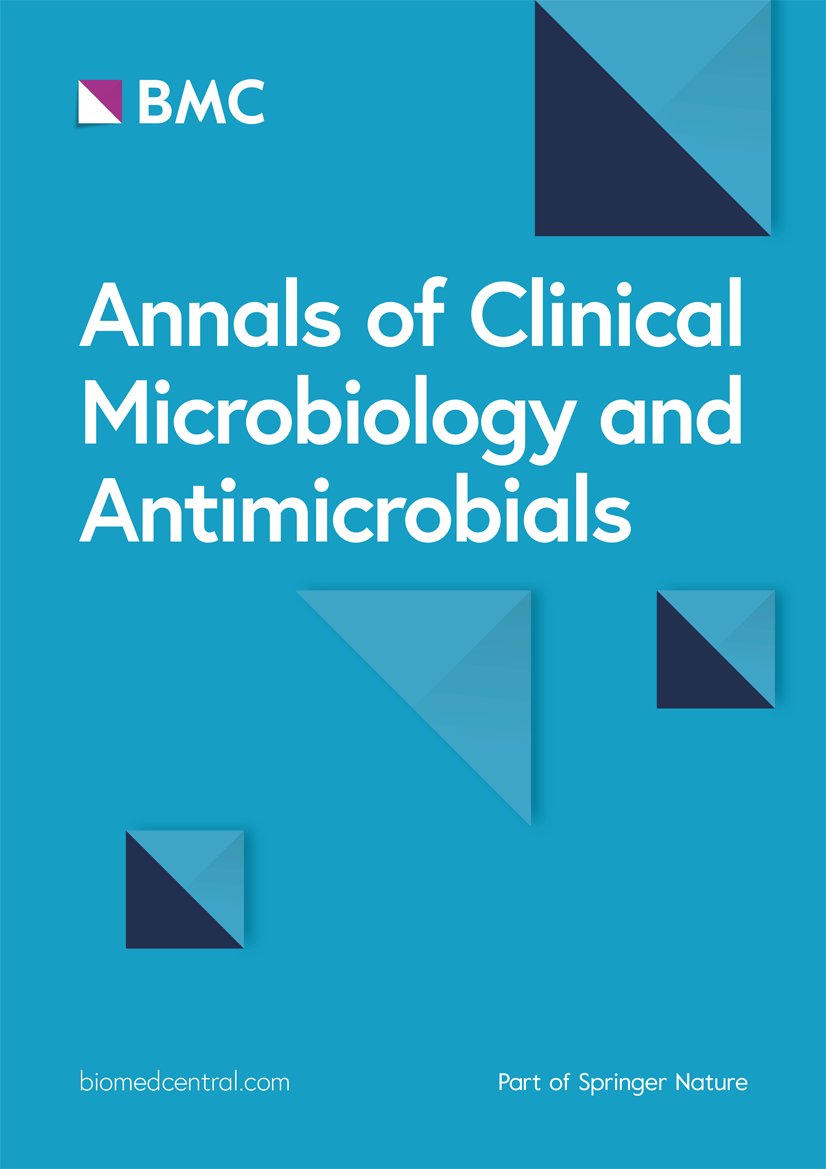亚胺培南/雷巴坦和头孢唑肟/阿维菌素对产 ESBL、KPC 和 AmpC 大肠埃希菌和肺炎克雷伯菌的体外抗菌活性的接种体效应比较
IF 4.6
2区 医学
Q1 MICROBIOLOGY
Annals of Clinical Microbiology and Antimicrobials
Pub Date : 2023-12-10
DOI:10.1186/s12941-023-00660-5
引用次数: 0
摘要
目的:评估产生广谱β-内酰胺酶(ESBL)、产生AmpC和产生KPC的大肠埃希菌和肺炎克雷伯菌的接种量对亚胺培南/雷巴坦(IMR)和头孢唑肟/阿维巴坦(CZA)体外抗菌效果的影响。我们通过抗菌药敏感性试验、时间致死试验和体外 PK/PD 研究,比较了接种物大小对 16 个临床分离株和 3 个标准分离株的 IMR 和 CZA 的影响。当接种量从 105 CFU/mL 增加到 107 CFU/mL 时,对 IMR 和 CZA 的接种量效应分别为 26.3%(5/19)和 52.6%(10/19);时间杀伤试验显示,CZA 的浓度从≥ 4 × MIC 增加到 16 × MIC 时,对肺炎双球菌 ATCC-BAA 1705(产 KPC-2、OXA-9 和 SHV-182)和 60,700 (产 SHV-27 和 DHA-1)的杀灭率达到 99.9%。而对于 IMR,1 倍 MIC 至 4 倍 MIC 的浓度可杀死 99.9% 的四种菌株。当接种量增加到 109 CFU/mL 时,IMR 和 CZA 即使在高浓度下也没有显示出可检测到的抗菌效果。一项体外 PK/PD 研究显示,当接种物增加时,IMR 的剂量为 1.25 克/q6h,具有明显的杀菌效果。对 CZA 的接种体效应比对 IMR 的更频繁。在产β-内酰胺酶的菌株中,产SHV和KPC的菌株最常出现接种体效应。本文章由计算机程序翻译,如有差异,请以英文原文为准。
Comparison of the inoculum effect of in vitro antibacterial activity of Imipenem/relebactam and Ceftazidime/avibactam against ESBL-, KPC- and AmpC-producing Escherichia coli and Klebsiella pneumoniae
To evaluate effect of inoculum size of extended-spectrum β-Lactamase (ESBL)-producing-, AmpC-producing-, and KPC-producing Escherichia coli and Klebsiella pneumoniae on the in vitro antibacterial effects of imipenem/relebactam (IMR) and ceftazidime/avibactam (CZA). We compared the impact of inoculum size on IMR and CZA of sixteen clinical isolates and three standard isolates through antimicrobial susceptibility tests, time-kill assays and in vitro PK/PD studies. When inoculum size increased from 105 to 107 CFU/mL, an inoculum effect was observed for 26.3% (5/19) and 52.6% (10/19) of IMR and CZA, respectively; time-kill assays revealed that the concentration of CZA increased from ≥ 4 × MIC to 16 × MIC to reach 99.9% killing rate against K. pneumoniae ATCC-BAA 1705 (KPC-2-, OXA-9- and SHV-182-producing) and 60,700 (SHV-27- and DHA-1-producing). While for IMR, a concentration from 1 × MIC to 4 × MIC killed 99.9% of the four strains. When the inoculum size increased to 109 CFU/mL, neither IMR nor CZA showed a detectable antibacterial effect, even at a high concentration. An in vitro PK/PD study revealed a clear bactericidal effect when IMR administered as 1.25 g q6h when inoculum size increased. An inoculum effect on CZA was observed more frequent than that on IMR. Among the β-lactamase-producing strains, the inoculum effect was most common for SHV-producing and KPC-producing strains.
求助全文
通过发布文献求助,成功后即可免费获取论文全文。
去求助
来源期刊

Annals of Clinical Microbiology and Antimicrobials
MICROBIOLOGY-
CiteScore
8.60
自引率
0.00%
发文量
49
审稿时长
>12 weeks
期刊介绍:
Annals of Clinical Microbiology and Antimicrobials considers good quality, novel and international research of more than regional relevance. Research must include epidemiological and/or clinical information about isolates, and the journal covers the clinical microbiology of bacteria, viruses and fungi, as well as antimicrobial treatment of infectious diseases.
Annals of Clinical Microbiology and Antimicrobials is an open access, peer-reviewed journal focusing on information concerning clinical microbiology, infectious diseases and antimicrobials. The management of infectious disease is dependent on correct diagnosis and appropriate antimicrobial treatment, and with this in mind, the journal aims to improve the communication between laboratory and clinical science in the field of clinical microbiology and antimicrobial treatment. Furthermore, the journal has no restrictions on space or access; this ensures that the journal can reach the widest possible audience.
 求助内容:
求助内容: 应助结果提醒方式:
应助结果提醒方式:


